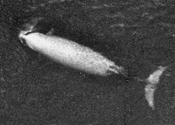|
| Query: beaked whale | Result: 11th of 107 | |
Cuvier's Beaked Whale (Ziphius cavirostris) - Wiki
| Subject: | Cuvier's Beaked Whale (Ziphius cavirostris) - Wiki
| |

| Resolution: 175x125
File Size: 46475 Bytes
Date: 2007:04:18 10:55:28
Upload Date: 2008:02:05 11:28:46
|
Cuvier's Beaked Whale
From Wikipedia, the free encyclopedia
Order: Cetacea
Suborder: Odontoceti
Family: Ziphidae
[Photo] Cuvier's Beaked Whale (Ziphius cavirostris). Source: NMFS Southwest Fisheries Science Center (www.nmfs.noaa.gov/pr/species/mammals/cetaceans/beakedwhales.htm)
Cuvier's Beaked Whale, Ziphius cavirostris is the most widely distributed of all the beaked whales. It is the only member of the genus Ziphius. Another common name for the species is Goose-beaked Whale on account of the fact that its head is said to be shaped like the beak of a goose. In fact, sightings of this creature were interpreted, during the Middle Ages, as a monster with a fish's body and an owl's head. This marine mammal was first described by Georges Cuvier in 1823 from part of a skull found in France in 1804.
Physical description
Cuvier's Beaked Whale has a short beak in comparison with other species in the family, making for a slightly bulbous-shaped melon. The melon is white or creamy in colour and the white strip continues back to the dorsal fin about two-thirds of the way along the back. The rest of the body varies from individual to individual in colour, some are dark grey, others a reddish-brown. Individuals commonly have white scars and patches caused by cookie-cutter sharks. The dorsal fin varies in shape from triangular to highly falcate. The fluke of the whale is about one-quarter the length body. The whale grows up to about seven metres in length and weighs 2-3 metric tonnes. They live for forty years.
The Cuvier's Beaked Whale is difficult to distinguish from many of the mesoplodont whales at sea.
Population and distribution
The distribution of Cuvier's Beaked Whale is known mainly from strandings. It has a widespread distribution across the Atlantic, Pacific and Indian Oceans. Individuals have been found as far north as the Shetland Islands and as south as Tierra del Fuego. Deep offshore waters are preferred in anything from cool to tropical waters. Studies have been carried out in the Bay of Biscay though sightings are infrequent there. Because of the difficulty of identifying the species the total global population is unknown.
Conservation
Japanese fisheries have in the past killed Cuvier's opportunistically. As with many other cetacean species many individuals are believed to be killed each year by gillnets. Beaked Whales may also be sensitive to noise. A higher incidence of strandings has been recorded in noisy seas such as the Mediterranean.
http://en.wikipedia.org/wiki/Cuvier's_Beaked_Whale
| The text in this page is based on the copyrighted Wikipedia article shown in above URL. It is used under the GNU Free Documentation License. You may redistribute it, verbatim or modified, providing that you comply with the terms of the GFDL. |
|
^o^
Animal Pictures Archive for smart phones
^o^
|
|

